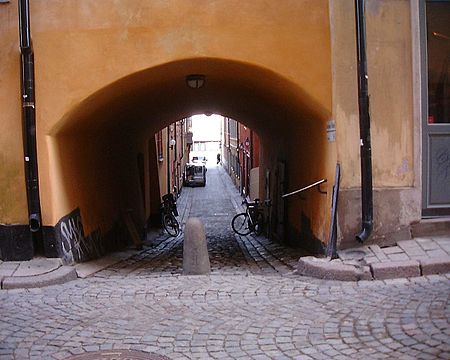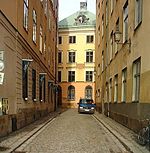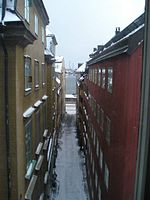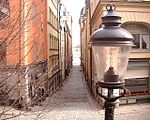Ferkens Gränd

Ferkens Gränd (Swedish: Alley of Ferken) is an alley in Gamla stan, the old town of Stockholm, Sweden, connecting Skeppsbron to Österlånggatan. It forms a parallel street to Drakens gränd, Lilla Hoparegränd, Pelikansgränd, and Gaffelgränd. In appears in historical records as Ferkens grändh in 1619, Farkens grändh in 1621, and Bredgränd (?).The alley derives its name from a simple restaurant[1] in the early 17th century found in the eastern end of the alley. It was called Farken or Ferken, a name derived from the German word Farch or Ferkel meaning 'pig', and it probably had a sign displaying a pig. A Leuisa i Farken ("Louise in the Fark") mentioned in 1602, was married to a Michill Wossin, who in June 1605 was allowed to run the tavern by King Charles IX. The establishment was however declared unfit in 1687 and the building demolished a few years later.
Excerpt from the Wikipedia article Ferkens Gränd (License: CC BY-SA 3.0, Authors, Images).Ferkens Gränd
Ferkens Gränd, Stockholm Gamla stan (Södermalms stadsdelsområde)
Geographical coordinates (GPS) Address External links Nearby Places Show on map
Geographical coordinates (GPS)
| Latitude | Longitude |
|---|---|
| N 59.32425 ° | E 18.074722222222 ° |
Address
Ferkens Gränd
Ferkens Gränd
111 31 Stockholm, Gamla stan (Södermalms stadsdelsområde)
Sweden
Open on Google Maps










